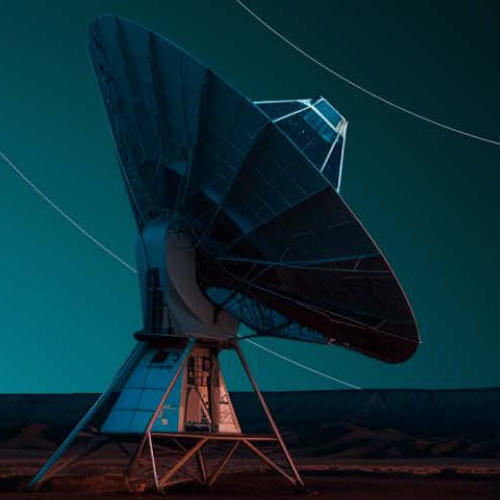I’m a simple man. It’s very kind of you to say that you agree with everything I just said, but I hadn’t fully finished my thought. What I was going to say was that I’m a simple man and I like a simple story. Sometimes I finish an interview with someone and—as soon as the video conference call closes—I burst into tears and/or maniacal laughter (figuratively, not literally, you understand… although sometimes it’s been a close call).
Happily, such was not the case when I just chatted with Zach Supalla, who is the Founder & CEO of Particle. Zach presented a story so simple that even I could understand it (only the story is simple—the underlying technology is awesome).
I remember first chatting with Zach around 10 years ago, shortly after Particle was founded. At that time, the company was focused on edge computing for internet of things (IoT) devices. The folks at Particle started out with Wi-Fi connectivity in the early “twenty-teens,” and later added cellular connectivity.
Now? Well, all I can say is “My, how they’ve grown!” On the hardware side of things, Particle offers system-on-module (SOM) units, development boards, and gateway devices. “So what,” you might say, “a lot of IoT companies offer SOMs and development boards.” In this case, I might reply, “Ah Ha! Just wait until you see the SOM I’m about to show you.” As awesome as the hardware is, however, the real differentiator is when Particle’s hardware is combined with its software.
As an aside, SOM is one of those abbreviations like LED (light-emitting diode) that causes endless grammatical confusion. Should we say “a SOM” or “an SOM”? Yes. It all depends on how you think about it and how you say this abbreviation when you are talking. If you say it as “SOM” to rhyme with “mom,” then “a SOM” is the way to go (similarly, “a LED” to rhyme with “bed”). This is the way I think about both of these. However, if you spell this abbreviation out as “S-O-M” then “an SOM” (that is, “an S-O-M”) is the preferred pronunciation and spelling, because the “S” sounds like “ess” and so acts like a vowel (similarly “an L-E-D” because the “L” sounds like “ell”). English; you have to love it. The bottom line is that both are correct, and the main thing is that—whichever you choose—you are consistent.
After building on things layer by layer, Particle now offers an entire IoT software stack, starting with edge computing, then network connectivity, then data automation, then management and administration. All users need to do is add their applications.
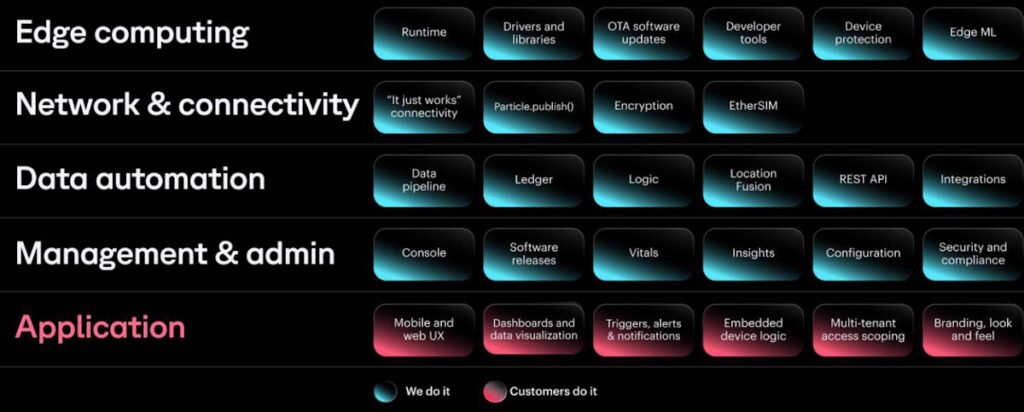
The IoT stack (Source: Particle)
In a crunchy nutshell, Particle is an IoT platform as a service. They sell a platform for companies who wish to make smart, connected devices, or IoT devices, or whatever you call them. The guys and gals at Particle provide everything their customers need, from embedded software to cloud software, with connectivity, networking, and data automation in between. Many manufacturing businesses have great products and a lot of expertise in making whatever kind of widgets they make. However, when they decide that they want to make their gizmos and gadgets smart, they may not have the same depth of expertise and scale of engineering resources required to build out the IoT technology stack from soup-to-nuts, which is where Particle leaps onto the center of the stage with a fanfare of sarrusophones (once heard, never forgotten). As a result, hundreds of manufacturers, thousands of startups, and 260,000+ developers now use Particle to power their IoT products.
The big thing about the IoT and connected devices is the “connectivity” part. I just mentioned Wi-Fi and cellular. Both are useful in different environments. Wi-Fi tends to be more applicable to smart home and office kinds of applications. In principle, Wi-Fi networks may also be used in warehouses and factories, but IT teams often balk at introducing IoT devices onto their networks. This is where cellular connectivity comes in as a kind of catchall.
The problem is that there are a lot of sites like oil and gas fields where the Wi-Fi network’s range is limited, and cellular connectivity is spotty at best. In these cases, low-power wide area networks (LPWANs) like LoRaWAN are often deployed. I’ve heard of LPWANs covering an area of around 250 miles, which isn’t too shabby, but what then? The next step up is to use non-terrestrial networks (NTNs) in the form of satellites orbiting the Earth.
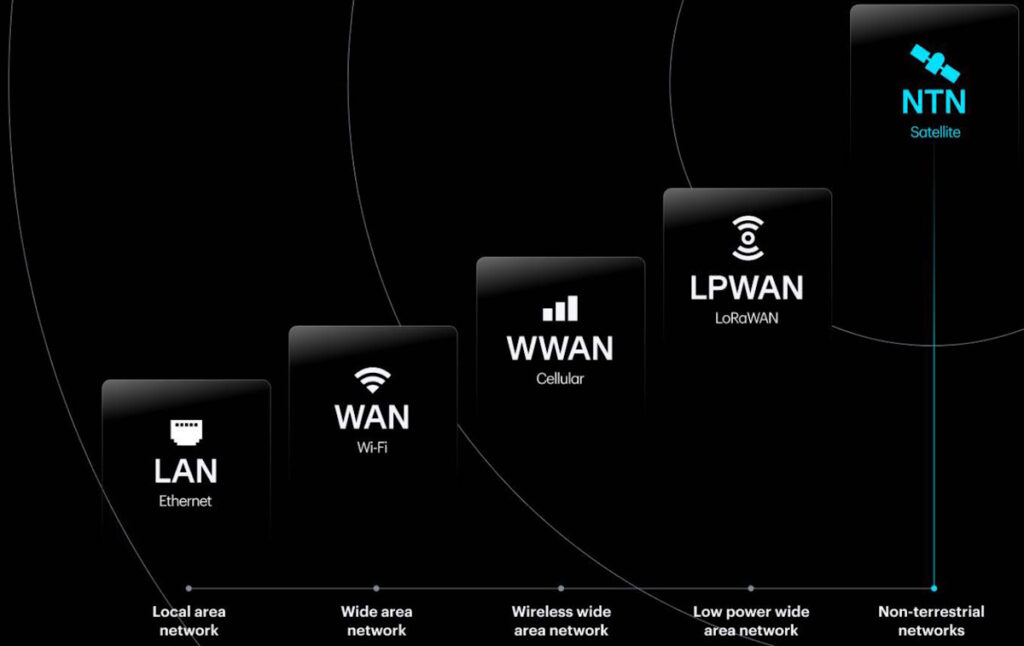
Different connectivity options (Source: Particle)
Now, sit up, pay attention, and prepare yourself to squeal in delight. The chaps and chapesses at Particle decided that the solution to all our problems is a SOM that provides all these connectivity options—something that can connect to different networks depending on what’s available. This is where we introduce the M-Series, which is pretty “M-azing” whichever way you look at it. There are multiple members of the M-Series SOM portfolio as illustrated below.
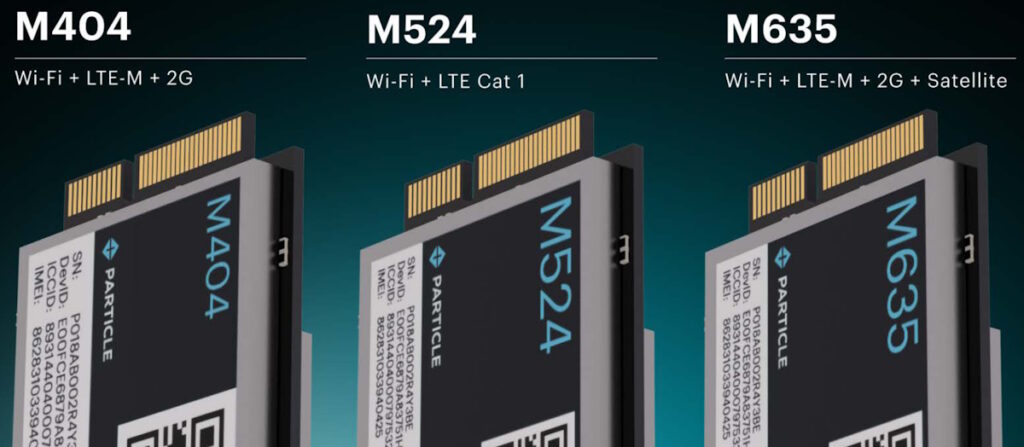
Meet the M-azing M-Series SOMs (Source: Particle)
For the purposes of these discussions, we’ll focus on the M635, which offers Wi-Fi, Cellular, LPWAN, and satellite communications in one pert little package that also features a heavy-duty microcontroller in the form of an Arm Cortex-M33.
This solution addresses multiple scenarios. The first is when a customer manufactures a product without knowledge as to in which environments particular units are going to be deployed. Using the M635, the product can be configured to connect to whichever network is available. Another consideration is the redundancy provided by the ability to connect to a preferred network, with the ability to fall back on other options as required.
Particle uses best-in-class silicon solutions to implement its M-Series SOMs, including a Qualcomm chip that handles cellular and satellite, a Realtek device that handles Wi-Fi, and an ST part that deals with LoRaWAN. The SOM also includes the four antennas required by the various protocols.
“Oh, joy,” I can hear you muttering to yourself, “now I’ve got to deal with four different radios, four different communication protocols, and four different networking implementations—this sounds like it’s going to make my life the opposite of easier.” To which I would reply, “Settle down. Take a chill pill. You are very cynical for one so young. I’ve not told you the good part yet.”
You know how a printf() function call in C/C++ will print whatever you tell it to, irrespective of the underlying hardware? Well, a Particle.publish() function call allows you to publish an event through the Particle Device Cloud that will be forwarded to all registered listeners. Remembering that all this is targeted at sensor-based applications, this is designed for payloads up to 1KB. If you want to send more data, you can break it up into a stream of payload packets. The key point here is that the Particle.publish() function will transmit the data via whatever communications channel is currently selected.
Similarly, you can use another line of code to establish your network preferences and priorities, along the lines of “First, try to use Wi-Fi, but if that fails try Cellular, and if that fails switch to Satellite.”
You want more “cool”? Well, connectivity is included “out of the box.” In the case of Particle’s existing cellular products, for example, there’s an embedded SIM (eSIM) on the product already—you don’t have to get a separate SIM part or data plan. This is included for free up to a hundred devices, and it’s included in Particle’s cloud service fees, so they don’t charge separately for data for cellular. They’re doing the same thing with these new SOMs.
In the case of satellite communications, there’s a new network operator called Skylo that’s one of the first to offer narrow-band IoT running over a satellite rather than over a cell tower. Skylo is the first to go live with this technology in the US and Europe, and they’ll be global by the end of the year.
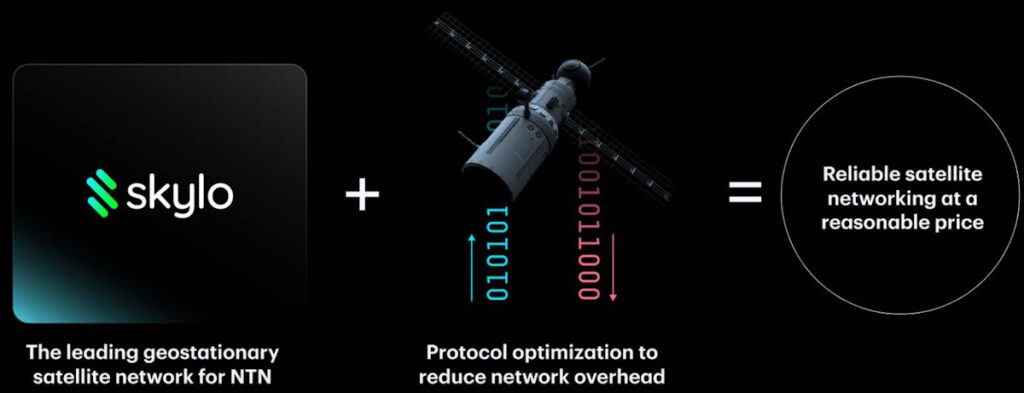
How Particle is implementing satellite connectivity (Source: Particle)
What all this means is that, in addition to launching a suite of “multi-radio” products that connect over four networks—Wi-Fi, cellular, LoRaWAN, and satellite—Particle is one of the first companies going live on the new LTE-over-satellite and will be the first company to make such a network accessible to everyday individuals like you and me.
“Could things get any better?” I hear you cry. Well, yes, they could. The folks at Particle are going to be shipping a $59 development board called the Muon that engineers, entrepreneurs, and tinkerers can use to build satellite-connected devices.
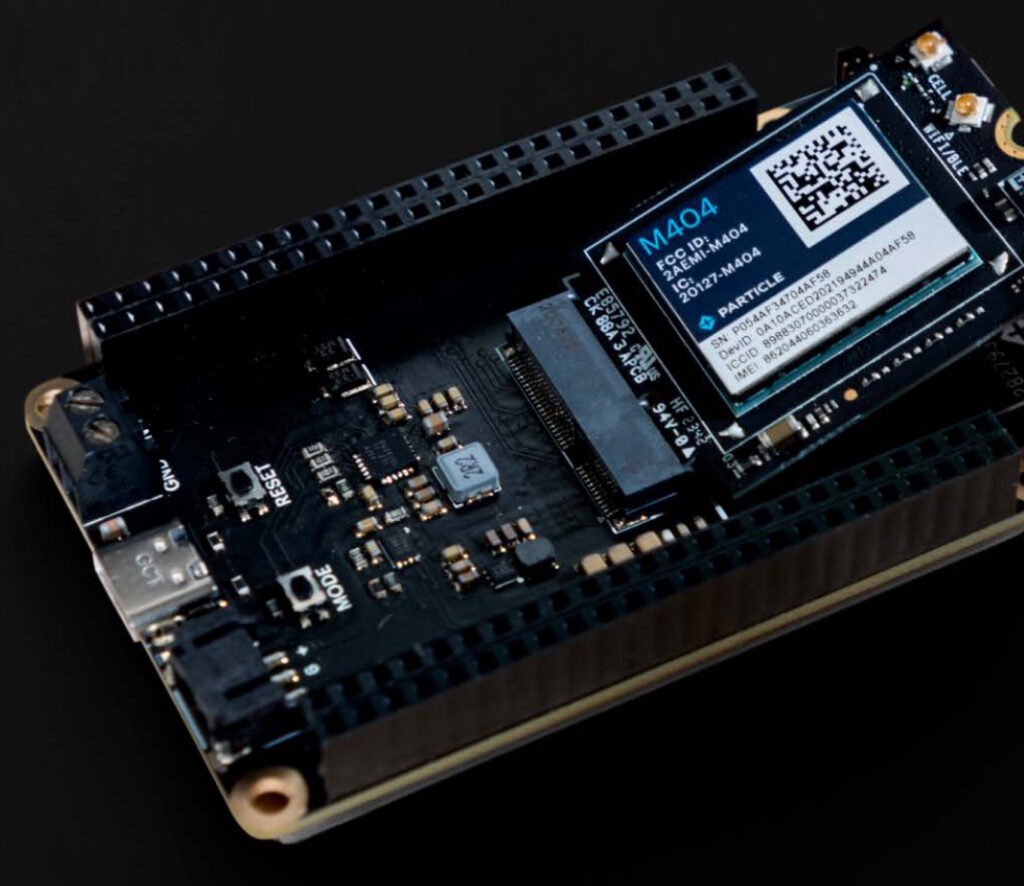
Meet the Muon (Source: Particle)
Observe the headers on either side of the Muon. In the same way that the M-Series SOM plugs into the Muon, users can create their own expansion cards that plug into these headers. Zach tells me that it won’t be long before Particle’s ecosystem partners will be announcing a suite of pre-build expansion cards (ooh, I hope that wasn’t supposed to be a secret).
I should point out that all the hardware discussed above is open-source, so you can use the Muon to develop a prototype, for example, and then re-spin everything as a custom board. Alternatively, you can simply deploy your Muon-based product into the field.
Of course, you are also going to need to develop an enclosure for your product. This is where you enter a whole new level of complexity. For example, how do you set about creating an enclosure rated at IP67, which is defined as being “dust resistant” and able to be “immersed in one meter of freshwater for up to 30 minutes”?
Once again, the folks at Particle have you covered, because they’ve already created an enclosure called the Particle Monitor One, which is billed as “A field-ready, yet customizable gateway.” What this means is that you can employ the Monitor One as-is, or you can take this open-source design and customize it to fully address your own unique requirements. The cool thing here is that, in the same way an M-Series SOM plugs into a Muon development board, the Muon plugs into the Monitor One, plus there’s room for you to add an expansion board.
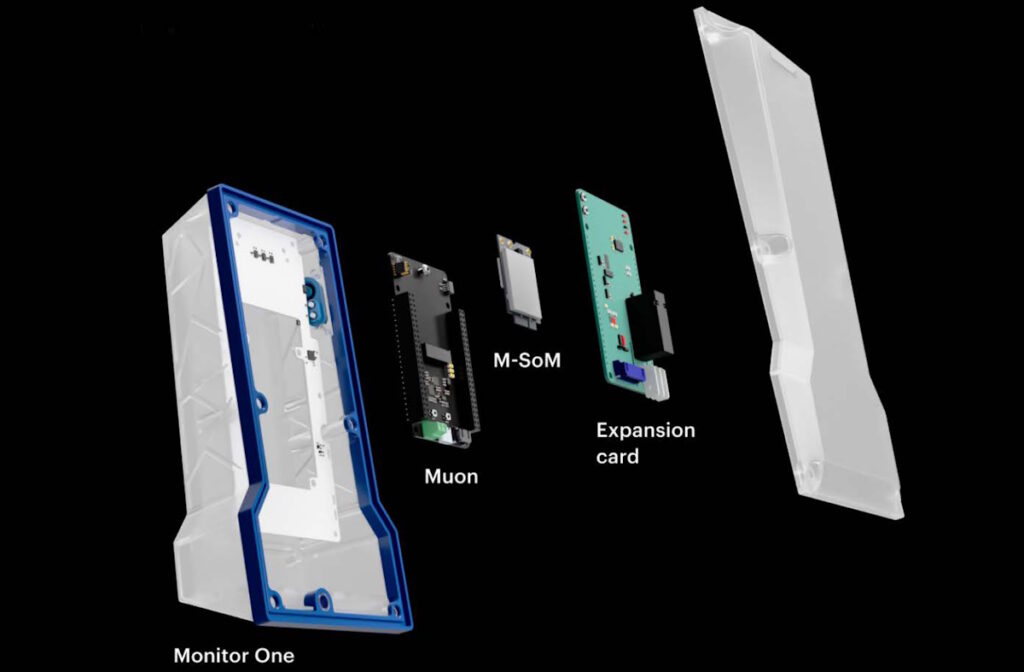
Stackable design for prototype to production (Source: Particle)
I must admit that I was impressed. In fact, when Zach introduced me to the Monitor One, the first thing I said was, “I must admit that I’m impressed,” so it must be true.
I went on to say, “I love the way you’ve used the SOM in the development board and then used the development board in the gateway. I’ve been exposed to many companies who would divide this into three totally separate things. So instead of plugging the SOM into the development board, for example, they would create a development board that included the SOM’s functionality.”
Zach responded with a somewhat rueful grin, saying, “I’m glad you appreciate that. It’s funny, you know. We’ve been doing this sort of thing for 10 years, but it was only now when we said to ourselves: ‘we could make all this a lot simpler if everything stacked.’ Why did we not do it that way in the first place?” I didn’t laugh because I’ve “been there and done that” myself.
I’ve seen the IoT grow from a figment of the imagination to the mind-boggling behemoth it is today, and every day I say to myself, “We ain’t seen nothin’ yet!” It blows my mind that this technology has progressed to the point where I could equip one of my hobby projects with not only Wi-Fi, and not only cellular, but with honest-to-goodness satellite communication capabilities. Goodness only knows what the folks at Particle will come up with next. What say you? What do you think about all of this?


